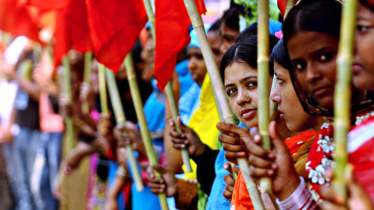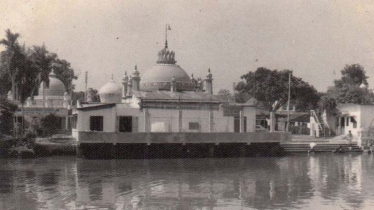
Photo : Messenger
The need for sustainable development calls for the urgency of proper utilisation of natural resources. The emergence of the blue economy in the 21st century replicates the core idea of sustainability. Through sustainable solutions and innovations, the blue economy promotes the idea of sustainably generating economic value from the untapped potential of marine resources to improve food security, nutrition, and health, reduce poverty, create jobs, increase trade and industrial profiles, preserve biodiversity and ecosystem health, and uphold regional peace and security. Oceans and seas are viewed by the Blue Economy as "Development Spaces" where maritime transportation, bioprospecting, renewable energy generation, oil and mineral riches extraction, conservation, and sustainable resource usage are all integrated into spatial planning considerations.
Bangladesh is a nation with enormous potential for a blue economy. Succeeding the resolution of the maritime boundary dispute between Bangladesh, Myanmar, and India between 2012 and 2014, the outcome favoured Bangladesh. Bangladesh's marine area grew by 30 percent as a result. The result is an additional 1 lakh 18 thousand 813 square kilometers of marine area for the nation which significantly raises its maritime potential. This win initiated the conceptualization of a futuristic sector that will need skilled manpower. "Bangabandhu Sheikh Mujibur Rahman Maritime University Bangladesh" was founded in 2013 to develop academic expertise in the field of blue economy growth. A department dedicated to oceanography has been established in several universities, including Dhaka University. Graduates from these departments are now actively working in several sectors of the blue economy in Bangladesh.
There are 26 productive blue-economy sectors identified in Bangladesh. According to several sources, over 90% of Bangladesh's outbound freight traffic is transported by sea, and the country's continued globalization has increased the significance of this trade. Currently, around 3000 foreign ships visit our ports carrying goods worth a combined USD 78 billion for Bangladesh for the year 2017–18. There are not enough Bangladeshi merchant ships; as of 2018, there are just 42 registered. Bangladesh must offer sufficient incentives to regional shipping firms to encourage them to expand their fleet of ships and to set up freight services, such as container liner services, so that commodities can be transported to and from Bangladesh on both chartered and domestic ships and freighters. A collaborative measurement of the public and private sectors needs to be on the table.
The next important factor is the establishment and proper management of seaports. Several datasets show that 94% of Bangladesh's foreign trade is transported through maritime ports, which are crucial to the country's economy. To accommodate rising trade and commerce, Bangladesh needs to create deep sea ports with more capabilities and contemporary handling equipment in Matarbari and Payra, as well as improve the handling and berthing capacities of existing ports like Chittagong and Mongla. The construction of seaports can result in a considerable reduction in export lead times as well as a consistent stream of income for the nation. China was supposed to build a port in Sonadia, another desirable location on the Bay of Bengal, but the development of the port of Matarbari will place a facility supported by Japan directly north of Sonadia. This has led some commentators to consider India to have won a strategic match between major countries in South Asia. Japan is seen as the winner in this scenario as well, as they are India's tag-team partner. Since that the construction of a deep sea port (DSP) might have a significant strategic impact on Bangladesh's rapid economic development, it is now needed. The nation would be able to take advantage of the connectivity provided by China's One Belt, One Road (OBOR) project with the establishment of such a port. In this regard, the plan to build a deep-water port at Sonadia merits particular consideration.
More than 300 shipyards and workshops can be found in Bangladesh. These yards build nearly all of the inland vessels that are needed, including fast patrol boats, dredging barges, passenger vessels, landing craft, tugs, supply barges, deck loading barges, speed boats, cargo coasters, troop-carrying vessels, hydrographic survey vessels, pilot boats, water taxis, and pontoons. Shipbuilding yards are anticipated to increase their capacity to 25,000 DWT. Currently, they are building 10,000 DWT seagoing ships for export. It should be offered possibilities and incentives for growth and expansion, as well as supported in all conceivable ways, including its businesses that are linked both horizontally and vertically. It would be prudent to thoroughly investigate more comparable industrial and engineering fronts, such as ship repair facilities.
For areas with suitable coastal features, marine-based renewable energy sources like wind, waves, tidal ranges, and currents have a large potential to contribute to low-carbon energy supplies. The term "offshore wind" refers to any activity involving the planning, design, and building of wind parks in marine environments as well as the utilization of wind energy to produce electricity offshore. Renewable energy derived from the sea can offer substitute jobs, especially to coastal towns that were formerly dependent on fishing. Overcoming technological obstacles and cutting costs requires targeted financial support from governments and consistent long-term policies. To put this into practice, financial incentives like grants, subsidies, and tax credits are needed to motivate private capital to invest in pilot plants rather than just little prototypes. The government has approved Denmark's USD 1.3 billion green investment plan to create Bangladesh's first 500 MW offshore wind farm. The project will commence with a full feasibility assessment and site exclusivity for the following three years. The proposal for foreign direct investment (FDI) was presented in July by Summit Power International of Bangladesh and Copenhagen Infrastructure Partners (CIP) in association with Copenhagen Offshore Partners (COP) of Denmark.
It's critical to put into practice modern, recently established ideas and concepts, such as ecosystem-based management (EBM) and the blue economy, to promote sustainable ocean governance. Marine Spatial Planning (MSP) can act as a key implementation tool for sustainable ocean governance, helping to realise the goals of the Blue Economy. The building of deep-sea ports in Bangladesh has far-reaching ramifications for regional connectivity and economic cooperation. As part of China's larger Belt and Road Initiative (BRI), these ports play an important role in improving marine trade routes and developing better cooperation among South Asian countries. Bangladesh may capitalise on its geographical advantage by improving ties with neighbouring countries such as India, Nepal, and Bhutan. It is anticipated that the many economic pursuits associated with Matarbari will add two to three percent to the GDP of the nation. This port's important function in supply chain management and logistics, as well as its influence on trade and business, will surely have a substantial impact on the nation's economic growth.
The writer is a lecturer at the Department of Environmental Science and Management of North South University.
Messenger/Fameema








